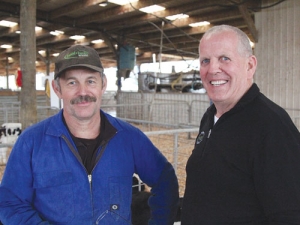Probiotics help calf rearing systems
Success in calf rearing is often measured by minimising health issues and achieving target weaning weights.
 Calf rearer Mark Bocock (left) with Doug Lineham, project manager Beef+Lamb Dairy Beef Integration Programme.
Calf rearer Mark Bocock (left) with Doug Lineham, project manager Beef+Lamb Dairy Beef Integration Programme.
The most surprising factor, when entering Mark and Michelle Bocock’s calf shed, isn’t the number of calves but the silence. There isn’t a sound.
All around hundreds of calves doze in the deep litter of the purpose-built warm, sheltered sheds capable of housing 2500 calves. A few nibble at feed. This contentment underplays the sophisticated operation which in one year rears 4000 four-day old calves to 12 weeks.
The Bococks have been rearing calves for 21 years, fine-tuning a formula which obviously favours the calves and suppliers, many of whom have stuck with them all that time.
“In the 1990s I ran a home-kill business and started rearing calves. The first year I reared 100, then 200 the following year and slowly built up to 4000 per season,” Mark says.
As the numbers grew, so did the need for more land with Mark and Michelle eventually settling on 24ha south of Cambridge where shedding was designed and built to enable today’s through-put of calves.
“Over 21 years we’ve reared 60,000 calves, a mix of dairy replacements and dairy/beef bulls, steers and heifers.”
Mark Bocock says that, over recent years with the high payout, calves have tended to be Friesian heifers with a declining number in dairy beef, but he expects this to change.
“When the payout was high farmers could afford to rear extra heifers to either add to the herd or be sold as dairy heifers, but the reduced payout will prompt some farmers to bring heifers home from grazing and they will rethink their calf strategy.”
Bocock said this changing demand has led to recent contacts from dairy grazers wanting to buy quality dairy/beef calves to grow in place of dairy heifers.
“The problem is finding those calves when farmer focus has been on breeding dairy calves. We do 1700 beefies with demand outstripping demand. This situation will change though, especially if dairy farmers review their mating plans this year.
“The buoyant beef market and demand for quality table beef means there’s a premium offering for quality dairy/beef.
“Beef + Lamb NZ is running a dairy beef integration programme with AgResearch which has highlighted the potential for dairy farmers to treble their income from calves by breeding the tail-end of the herd (after replacements) to proven beef genetics. This means that, this time next year, there’ll be more dairy/beef calves on the ground.”
Doug Lineham, the project manager for the dairy beef integration programme, gives the example of a 300 (Friesian) cow dairy farm, for example, mating 100 cows to high BW sires for replacements and the remainder to proven beef.
“There’s the potential to increase the calf cheque by $14,000 to $20,000 (based on the resulting Friesian/beef calves being worth $70 to $100 each more than straight dairy). That’s a nice Christmas bonus from a simple change in mating plans,” Lineham said.
With calving underway, Bocock is picking up around 800 calves per week from clients. “Most calves are reared on contract although we also rear calves which are onsold, as 12 week old/100 kg calves.”
Bocock recommends that farmers wanting to take advantage of the potential to increase earnings from calves in 2016-2017 should be talking with their AB companies or stock agents now.
“You need to ensure you’re breeding the balance of the herd to proven beef genetics, that is bulls registered and with economic breeding values giving you assurance on short gestation, easy calving, temperament, etc. There are lots of options out there – from breeds to access to proven bulls.”
Based on feedback to date, the number of calves in the Bocock sheds next year will be the same, but the composition might be different.
Rangitikei Rivers Catchment Collective (RRCC) chairperson Roger Dalrymple says farmers in his region are taking a national lead in water quality awareness and monitoring.
One young couple is proving farm ownership is still within reach for young Kiwis.
Greenlea Premier Meats managing director Anthony (Tony) Egan says receiving the officer of the New Zealand Order of Merit (ONZM) honour has been humbling.
Waikato dairy farmer Neil Bateup, made a companion of the New Zealand Order of Merit (CNZM) in the New Year 2026 Honours list, says he’s grateful for the award.
Another Australian state has given the green light to virtual fencing, opening another market for Kiwi company Halter.
Farmer interest continues to grow as a Massey University research project to determine the benefits or otherwise of the self-shedding Wiltshire sheep is underway. The project is five years in and has two more years to go. It was done mainly in the light of low wool prices and the cost of shearing. Peter Burke recently went along to the annual field day held Massey's Riverside farm in the Wairarapa.
President Donald Trump’s decision to impose tariffs on imports into the US is doing good things for global trade, according…
Seen a giant cheese roll rolling along Southland’s roads?